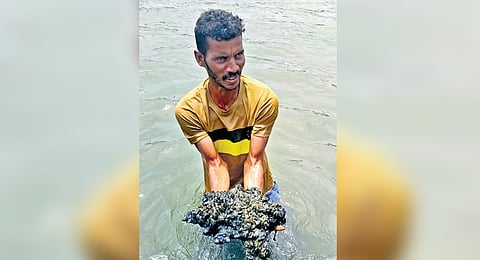

CHENNAI: The southern bench of National Green Tribunal (NGT) has expressed concern over the state government’s sluggish progress in addressing the invasive charru mussel infestation in the Ennore-Pulicat wetland, a critical ecosystem supporting thousands of fishermen. Two years after the issue was raised, the tribunal questioned the state’s commitment to restoring these ecologically vital waters.
When the case came up for hearing on Wednesday, the NGT bench, comprising judicial member Justice Pushpa Satyanarayana and expert member K Satyagopal, posted the case for the second week of August and sought a clear roadmap for removal of charru mussels.
Charru mussel, a South American invasive species, has wreaked havoc in Ennore Creek, Pulicat lake, and Kosasthalaiyar backwaters, displacing native bivalves like yellow clams and green mussels, and disrupting prawn behaviour. Local fishermen report a thick layer of foul-smelling excrement covering the lake bed, threatening their livelihood.
The state Wetland Authority filed a report outlining ongoing efforts, but Water Resource Department is asking for a Rs 20.85 crore to dredge 2.2 km in Kattupalli and Puzhuthivakkam and had approached Tamil Nadu Pollution Control Board and Tangedco for funding.
When the case was first filed by Ennore resident S Kumaresan in 2023, the invasive mussel species spread was observed in a 7 km stretch, but as per latest estimate the spread is noticed on a 24km stretch, which could further steeply increase the WRD’s estimate manifold.
M Magesh Nagarajan, superintending engineer (WRD), Palar Basin Circle, said dredging activities in the Athipattu village on a 1.7 km stretch located near the NCTPS bridge along the Kosasthalaiyar backwater are currently under way.
“As of May, 1.05 km has been dredged. Work is expected to be completed by August end. The operation resulted in removal of 2.6 lakh cubic metres of heterogeneous material, including a substantial mix of fly ash and aggregated charru mussels. It is estimated that mussel biomass constitutes nearly 8% of the total volume. The removal work is being carried out from Athipattu and moving towards Kattupalli based on the fund allocation. Hence, a comprehensive proposal with an estimate of Rs 20.85 cr was submitted.”
Meanwhile, the National Centre for Sustainable Coastal Management (NCSCM) is mapping the mussel’s spread, sampling 148 locations along a 20km stretch of Ennore Creek. Community mapping with local fishermen on May 2 identified infestation hotspots, with a final report due by September.
Dr MGR Fisheries College, Ponneri, reports minimal mussel presence in dredged areas, with native species like yellow mussels and bioindicators showing signs of recovery, suggesting potential ecosystem restoration. The fisheries college is also studying the feasibility to convert charru mussels into biofertilizers and mineral mixes. A commercial plan for fishermen is in development, but heavy metal testing and standardisation are pending, said Srinivas R Reddy, member secretary of state Wetland Authority.